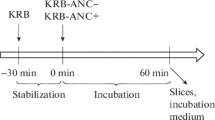Summary
Clorgyline (0.3–10mg/kg, i.p.) inhibited type A monoamine oxidase (5-hydroxytryptamine as substrate) but not type B monoamine oxidase (phenylethylamine as substrate) in homogenates of rat striatum and olfactory tubercle; deprenyl (0.3–3 mg/kg, i.p.) inhibited type B but not type A monoamine oxidase in these homogenates. The same doses of clorgyline increased concentrations of dopamine in striatum, and dopamine and norepinephrine in the olfactory tubercle, median eminence and posterior pituitary; they also reduced the concentrations of dihydroxyphenylacetic acid and the rate of synthesis of dopamine (DOPA accumulation after a decarboxylase inhibitor) in the same brain regions. On the other hand, the administration of deprenyl at doses that markedly inhibited type B monoamine oxidase did not alter the concentrations of dopamine, norepinephrine and dihydroxyphenylacetic acid or the rate of accumulation of DOPA in these brain regions. In addition, only clorgyline significantly lowered serum concentrations of prolactin. These results suggest that type A monoamine oxidase catalyzes the intraneuronal deamination of dopamine within terminals of nigrostriatal, mesolimbic, tuberoinfundibular and tuberohypophyseal dopamine neurons.
Similar content being viewed by others
References
Atack, C. V., Magnusson, T.: Individual elution of noradrenaline together with adrenaline, dopamine, 5-hydroxytryptamine and histamine from a single, strong cation exchange column, by means of mineral acid organic solvent mixtures. J. Pharm. Pharmac.22, 625 (1970).
Björklund, A., Moore, R. Y., Nobin, A., Stenevi, U.: The organization of tuberohypophyseal and reticulo-infundibular catecholamine neuron systems in the rat brain. Brain Res.51, 171–191 (1973).
Carlsson, A., Kehr, W., Lindquist, M., Magnusson, T., Atack, C. V.: Regulation of monoamine metabolism in the central nervous system. Pharmacol. Rev.24, 371–384 (1972).
Chen, H. T., Simpkins, J. W., Mueller, G. P., Meites, J.: Effects of pargyline on hypothalamic biogenic amines and serum prolactin, LH, and TSH in male rats. Life Sci.21, 533–541 (1977).
Coquil, J. F., Goridis, C., Mack, G., Neff, N. H.: Monoamine oxidase in rat arteries: Evidence for different forms and selective localization. Brit. J. Pharmacol.48, 590–599 (1973).
Demurest, K. T., Alper, R. H., Moore, K. E.: DOPA accumulation is a measure of dopamine synthesis in the median cminence and posterior pituitary. J. Neural Transmission46, 183–193 (1979).
Demurest, K. T., Moore, K. E.: Comparison of dopamine synthesis regulation in the terminals of nigrostriatal, mesolimbic, tuberoinfundibular and tuberohypophyseal neurons. J. Neural Transmission46, 263–277 (1979).
Demurest, K. T., Moore, K. E.: Accumulation of L-Dopa in the median eminence: An index of tuberoinfundibular dopaminergic nerve activity. Endocrinology106, 463–468 (1980).
Demarest, K. T., Smith, D. J., Azzuro, A. J.: The presence of the type A form of monoamine oxidase within nigrostriatal dopamine-containing neurons. J. Pharmacol. Exp. Ther.215, 461–468 (1980).
Goridis, C., Neff, N. H.: Monoamine oxidase in sympathetic nerves: A transmitter specific enzyme type. Brit. J. Pharmacol.43, 814–818 (1971).
Hall, D. W. R., Logan, B. W., Parsons, G. H.: Further studies on the inhibition of monoamine oxidase by M+B 9302. Biochem. Pharmacol.18, 1447–1454 (1969).
Horn, A. S., Cuello, A. C., Miller, R. J.: Dopamine in the mesolimbic system of the rat brain: Endogenous levels and the effects of drugs on the uptake mechanisms and stimulation of adenylate cyclase activity. J. Neurochem.22, 265–270 (1974).
Jarrott, B., Iversen, L. L.: Noradrenaline metabolizing enzymes in normal and sympathetically denervated vas deferens. J. Neurochem.18, 1–6 (1971).
Johnston, J. P.: Some observations upon a new inhibitor of monoamine oxidase; inhibitor drugs to modify amine metabolism in brain. Biochem. Pharmacol.17, 1285–1297 (1968).
Keane, P. E., Francoise, C., Benedetti, M. S.: The effects of specific type A and B MAO inhibitors on reserpine-induced changes in brain dopamine and serum prolactin levels in the rat. In: Monoamine Oxidase: Structure, Function and Altered Function (Singer, T. P., Von Korfl, R. W., Murphy, D. L., eds.), pp. 341–346. New York: Academic Press. 1979.
Knoll, J., Magyar, K.: Some puzzling pharmacological effects of monoamine oxidase inhibitors. Adv. Biochem. Psychopharmacol.5, 393–408 (1972).
Lowry, O. H., Rosebrough, N. J., Farr, A. L., Randall, R. J.: Protein measurement with Folin phenol reagent. J. Biol. Chem.193, 265–275 (1951).
MacLeod, R. M., Login, I.: Control of prolactin secretion by the hypothalamic catecholamines. Adv. Sex Hormone Research2, 211–231 (1976).
Moore, R. Y., Bloom, F. E.: Central catecholamine neuron systems: Anatomy and physiology of the dopamine systems. Ann. Rev. Neurosci.1, 129–169 (1978).
Roth, R., Walters, J. R., Morgenroth, V. H.: Effects of alterations in impulse flow on transmitter metabolism in central dopaminergic neurons. In: Neuropsychopharmacology of Monoamines and Their Regulatory Enzymes (Usdin, E., ed.), pp. 369–384. New York: Raven Press. 1974.
Sokal, R. R., Rohlf, F. J.: Biometry, 2nd ed. San Francisco: W. H. Freeman. 1969.
Umezu, K., Moore, K. E.: Effects of drugs on regional brain concentrations of dopamine and dihydroxyphenylacetic acid. J. Pharmacol. Exp. Ther.205, 49–56 (1979).
Waldmeier, P. C., Delini-Stula, A., Maitre, L.: Preferential deamination of dopamine by an A type monoamine oxidase in rat brain. Naunyn-Schmiedeberg's Arch. Pharmacol.292, 9–14 (1976).
Yang, H.-Y. T., Neff, N. H.:gb-Phenylethylamine: A specific substrate for type B monoamine oxidase of brain. J. Pharmacol. Exp. Ther.187, 365–371 (1973).
Yang, H.-Y. T., Neff, N. H.: The monoamine oxidases of brain: Selective inhibition with drugs and the consequences for the metabolism of the biogenic amines. J. Pharmacol. Exp. Ther.189, 733–740 (1974).
Author information
Authors and Affiliations
Rights and permissions
About this article
Cite this article
Demarest, K.T., Moore, K.E. Type A monoamine oxidase catalyzes the intraneuronal deamination of dopamine within nigrostriatal, mesolimbic, tuberoinfundibular and tuberohypophyseal neurons in the rat. J. Neural Transmission 52, 175–187 (1981). https://doi.org/10.1007/BF01249602
Received:
Issue Date:
DOI: https://doi.org/10.1007/BF01249602



